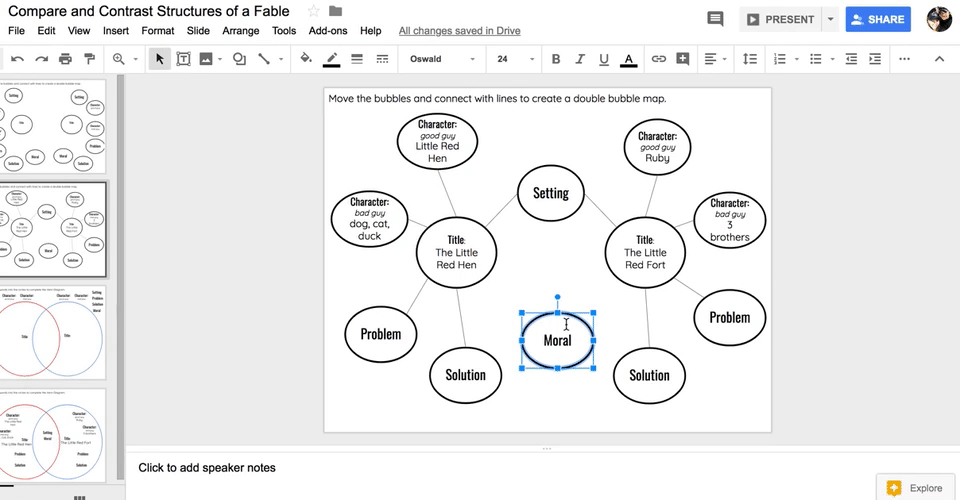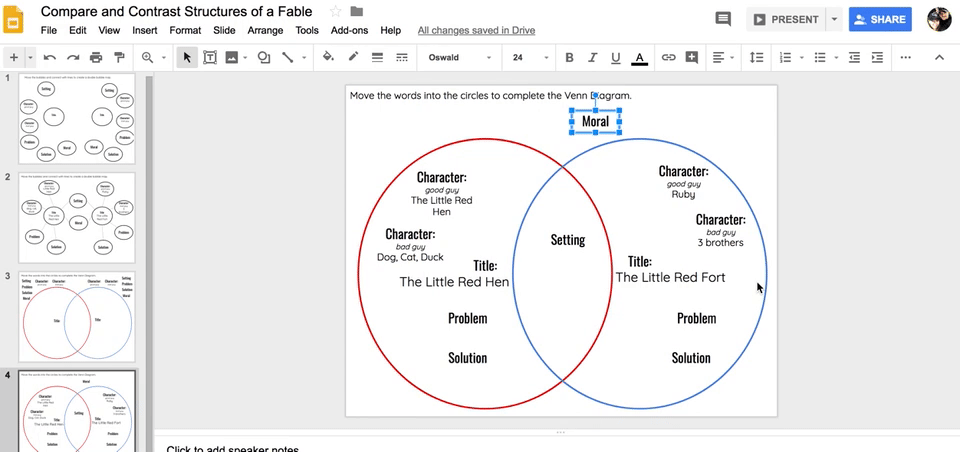This post contains affiliate links for your convenience, and at no cost to you.
Long ago (back in 2011), when I was a second grade teacher, I wrote this post called Fairytales and Fables Unit. In this post I focused on how to teach students the structure of fairytales and fables so that they could understand how those stories worked and use the structure to write their own fairytale or fable. It included lots of great mentor texts, ideas for aligning literacy centers, and a celebration to wrap it up–a fairytale ball! While that post is a bit dated, the idea of teaching the structural elements of these stories is still a good one that aligns with Common Core State Standards. Folktales are still a focus of the CCSS in 2nd and 3rd grade:
RL.2.2 Recount stories, including fables and folktales from diverse cultures, and determine their central message, lesson, or moral.
RL.3.2 Recount stories, including fables, folktales, and myths from diverse cultures; determine the central message, lesson, or moral and explain how it is conveyed through key details in the text.
Studying the structural elements of a story is also a standard in 2nd, 4th, and 5th grade:
RL2.5 Describe the overall structure of a story, including describing how the beginning introduces the story and the ending concludes the action.
RL.4.5 Explain major differences between poems, drama, and prose, and refer to the structural elements of poems (e.g. verse, rhythm, meter) and drama (eg. casts of characters, settings, descriptions, dialogue, stage directions) when writing or speaking about a text.RL5.5 Explain how a series of chapters, scenes, or stanzas fits together to provide the overall structure of a particular story, drama, or poem.
I love connecting STEAM (science, technology, engineering, art, math) and literacy in the classroom, so I'm going to use some of the same teaching points as the original post I wrote in 2011 with some modern updates using 3 of the best fractured folktales I have come across that highlight engineering and the design process.
This story is based on the classic fable The Little Red Hen, but in this story, Ruby is a little girl who wants to build a fort. She asks her brothers for help, but they laugh at her and tell her she can't build. Just like the original fable, Ruby works through the steps it takes to build her fort (following most of the steps in the engineering design process) while asking her brothers for help each step of the way, but they're always too busy, or just not interested until they see the fort that she made herself.
I love that this story has diverse characters and an emphasis on STEAM!


Studying fractured fables, different versions of a classic fable, gives students a great opportunity to compare and contrast texts by analyzing stories with the same structure:
RL.2.9 Compare and contrast two or more versions of the same story (e.g., Cinderella stories) by different authors or from different cultures.
RL.3.9 Compare and contrast the themes, settings, and plots of stories written by the same author about the same or similar characters (e.g., in books from a series).
RL.4.9 Compare and contrast the treatment of similar themes and topics (e.g., opposition of good and evil) and patterns of events (e.g., the quest) in stories, myths, and traditional literature from different cultures.
RL.5.9 Compare and contrast stories in the same genre (e.g., mysteries and adventure stories) on their approaches to similar themes and topics.
Using the digital interactive notebook pages shown above, you can show students that the characters, the problem, and the solution are different, or fractured in The Little Red Fort. Instead of using animals, the main characters are human. Instead of baking bread, Ruby wants to build a fort. In the end, Ruby doesn't let her brothers play in the fort since they didn't help, but the story doesn't end there. Instead, they find ways to improve the fort, and Ruby lets them join her for a celebration inside. You can compare and contrast these stories with a double bubble map if you use Thinking Maps, or a Venn Diagram.
Engineering: This book is a great example for modeling how the Engineering Design Process works, which aligns with ISTE standard 4a: Students know and use a deliberate design process for generating ideas, testing theories, creating innovative artifacts or solving authentic problems.
According to Engineering in Elementary, to solve engineering problems, engineers follow a series of steps called the "Engineering Design Process."
ASK: What is the problem? How have others approached it? What are your constraints?
IMAGINE: What are some solutions? Brainstorm ideas. Choose the best one.
PLAN: Draw a diagram. Make lists of materials you will need.
CREATE: Follow your plan and create something. Test it out!
IMPROVE: What works? What doesn't? What could work better? Modify your design to make it better. Test it out!
In this story, Ruby asks herself and her brothers what she can build using the boards she finds (the constraints). Her brothers also tell her that she doesn't know how to build anything so she learns how (answering the question, how have others approached it?). We have to infer that she went through the imagine stage when she decided to build a fort because it is not directly stated. She plans her fort and creates it all by herself. Her brothers help her improve her fort by adding a mailbox, flowers, and painting it fire-engine red. At the end of the story, there are suggestions for building a fort of their own: a sofa fort, a kitchen chair fort, a snow fort, or a bunk-bed fort. Have students use the Engineering Design Process sheet to build a fort as homework. Using a program like Seesaw, students could even add pictures, video, and voice to illustrate how they used the Engineering Design Process to build their own fort at home.
VS.
2. The Three Little Pigs: An Architectural Tale by Steven Guarnaccia
This fractured folktale is a version of the classic Three Little Pigs, but their homes are made of scraps, glass, and stone and concrete. The house designs are inspired by 3 famous architects: Frank Gehry, Phillip Johnson, and Frank Lloyd Wright. Many more world-renowned designers' work is featured throughout the story, which makes this a perfect book to make a STEAM connection.
ELA lesson: This is another great story to compare and contrast to the original version of the Three Little Pigs. The Structures of a Folktale text map (above) is an example of what the structure of The Three Little Pigs: An Architectural Tale might look like. The digital interactive notebook pages show how students might compare the structures of these folktales.
This story also gives students a great opportunity for research on the 3 famous architects highlighted in this story: Frank Gehry, Phillip Johnson, and Frank Lloyd Wright. By researching the type of structures these architects create, students can get a sense for the design and artistry behind thearchitecture.
This story also gives students a great opportunity for research on the 3 famous architects highlighted in this story: Frank Gehry, Phillip Johnson, and Frank Lloyd Wright. By researching the type of structures these architects create, students can get a sense for the design and artistry behind thearchitecture.
Engineering: Now it's the students' turn to build! Using the engineering design process, have students become an architect that was hired to design a house for the three little pigs. Students must begin the Engineering Design Process by asking themselves: What will be strong enough to keep the big bad wolf from blowing it down? Is it beautiful? Using the influence of the architect they like best, students must make a plan and create a model of their design. Give them a variety of materials to use such as cardboard, plastic cardboard screws, clear plastic bottles, and legos. Let students know that just because the concrete house in the story was the one the wolf couldn't blow down, it doesn't mean that it is the one they have to build. If they build it well, it will remain standing.
VS.
3. The 3 Pigs and the Scientific Wolf by Mary Fetzner
This fractured folktale is about the daughters of the 3 Little Pigs and the Big Bad Wolf's son. "He, like most children, was sure he was wiser and more clever than his father. He just knew that he could figure out an easier way to catch those delightful piglets." So the scientific wolf tries to use simple machines to catch the 3 little pigs. At the first house made of straw, he uses a pulley to try to get in. At the second house made of sticks, he tries riding a bicycle up an incline plane, and at the third house made of bricks he uses a crowbar as a lever. When that doesn't work he tries lifting the house with a corkscrew jack. He never figures out a way to get into the pigs' houses, so he decides to become a vegetarian.
Disclaimer: I think it's important to know that this book is not a traditional book. The pictures inside the book are not in color, and pages 32 - 64 are student activity pages that outline a unit about simple machines. This book was published in 2000, and the activities at the end are not rigorous enough or hands-on enough for me, personally. I loved the idea of the wolf using simple machines so much, however, that I thought it was worth it to have the story! It opens the door for some great STEAM possibilities!
ELA lesson: Like the first two stories, fill out the Structures of a Folktale text map for this story and compare and contrast it to the original Three Little Pigs using the double bubble map or the Venn Diagram from the digital interactive notebook pages.
Engineering: Using this story and The Three Little Pigs: An Architectural Tale would be a great opportunity to create PBL unit about simple machines.
Pulleys
Levers
Inclined Planes
Wheels and Axles
Simple Machine: The Screw
Once students have learned about simple machines, they will be hired as part of a security team to make sure that the houses they designed for the Three Little Pigs (created in The Three Little Pigs: An Architectural Tale) are safe from the scientific wolf. Their job is to try to break into their model house using simple machines just like the scientific wolf. They will make improvements to their design until it is safe from at least 3 different attacks by the wolf. Then they will create a presentation for the 3 pigs that shows how they secured the house from 3 different simple machines that the wolf might use to get into the house. When creating their presentations, they could use iMovie, the Doink Green Screen app, or the Stop Motion Animation app. There are a lot of possibilities!
Another great connection to a simple machines unit is St. Patrick's Day STEM Challenge: Build a Leprechaun Trap with Simple Machines.
After your students have designed and engineered forts, houses, and simple machines, they can use the Structures of a Fable or Folktale to create their own fractured story that includes some engineering! Maybe Jack can use simple machines to break into the giant's house, or Goldilocks gets community service for breaking into the 3 bears house, and she has to redesign the inside of their house like an episode of Fixer Upper. With lots of opportunities for hands-on learning, I'm sure the students creativity will amaze you!
The text maps, digital interactive notebooks, engineering design process sheet, and all the movies embedded in this post are available for download here on Teacher Sherpa.
Enjoy!








































